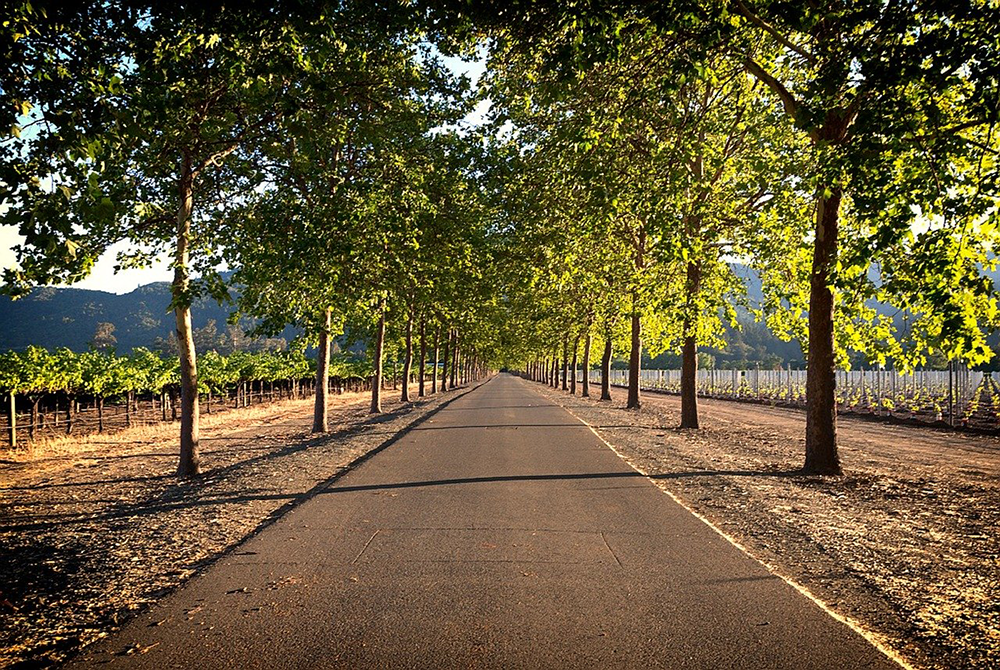
By Mike DuBose, Debra DuBose, and Blake DuBose
Napa Valley’s is one of the world’s 15 best wine-producing regions, according to Business Insider magazine—an achievement even more impressive considering that the area has only gained its reputation over the last five decades. Although the industry was growing in the second half of the 19th century, many wineries shut down during Prohibition in the 1920s, and it took decades to recover. According to Michael Bauer of SFGate.com, “not until Robert Mondavi opened his winery in Oakville in 1966 did the valley begin to gain respect.” Another turning point came in 1976 with “The Judgement of Paris,” where a Napa Valley Chardonnay and a Cabernet Sauvignon beat out French wines in a blind tasting with French judges!
Today, Napa Valley turns out 9 million cases of wine per year, according to a 2015 USA Today article by Tammy Kennon, despite being one of the smallest wine-growing regions in the world. Napa Valley’s 30-mile stretch of land, which covers 45,000 acres, is home to more than 400 wineries. If you include nearby Sonoma Valley as well, the number rises to 600. Napa and Sonoma are competitive with each other, however—we saw one t-shirt that said, “Sonoma makes wines and NAPA makes parts!” Each acre grows about 2 to 3 tons of grapes (or about 100 cases of wine) per year, and wine-growing land costs a whopping $700,000 per acre!
Getting There
The Napa Valley is located about 45 miles to the northeast of San Francisco. Many people choose (as we did) to fly into San Francisco, spend some time there, and then drive out to the Napa Valley. If you are planning to do this, be warned that traffic in the San Francisco area is horrific, and it can be very stressful! We recommend leaving San Francisco for the valley between 10 AM and 2 PM to hit the road during the lightest traffic periods.
Where to Stay
We stayed in the city of Napa, which is the seat of Napa County. It was founded in 1847, “an old city for California standards,” according to the town’s website, which describes Napa as “a place with a colorful past—a jumping off point for 49ers bound for the gold rush, birthplace of famous leather, and neighbor to some of the most prestigious vineyards in the world.” There are also many smaller towns in Napa County with accommodations, such as St. Helena and Yountville, but we found that Napa best suited our needs.
In August 2014, an earthquake measuring a 6.0 on the Richter scale struck just 6 miles southwest of Napa, injuring more than 100 people and damaging dozens of buildings in the city’s historic downtown. Many restaurants and wine warehouses in the area also lost thousands of dollars’ worth of wine due to broken barrels and bottles. SFGate.com quoted local winery owner Carole Meredith, who said, “This is going to be a really expensive earthquake for the wine business.” However, when we visited roughly a year after the earthquake, the city (and the region) appeared to have mostly recovered, no doubt motivated by the lucrative tourism and hospitality business—an industry that brought $1.63 billion dollars in visitor spending to Napa County in 2014. In fact, hotel guests spent nearly $400 per person per day on average, according to a survey by Visit Napa Valley.
In the city of Napa, we stayed at Embassy Suites on California Boulevard, which was about 8 blocks from the city center. It was a very good hotel with nice rooms and friendly staff. Free drinks and snacks were offered between 5:30 and 7:30 PM, and a continental breakfast was included. Be sure to ask for a room away from the breakfast area, which can get noisy in the mornings!
Napa Facts
During our time in Napa, we learned many fascinating facts about the wine industry, how wine is produced, and the reasons that some wines are more expensive than others. For example, higher-quality wineries pick their grapes at night by hand to enhance the juice and flavor. Farm workers use headlights on their foreheads to see, and they work quickly and efficiently. They are paid by the ton, and eight workers can pick one acre each hour! Larger wineries that make inexpensive wines (including one that produces 100 million bottles of wine annually) use machines to harvest the grapes. This is faster and less expensive than hiring humans, but it also means that some living things (including spiders, lizards, bugs, snakes, and birds) may end up being “picked” by the machine and included in the cheaper wines.
Napa Valley’s Mediterranean-esque climate is a huge factor in its success as a winemaking region. There are 16 different sectors and 7 microclimates in Napa, and its days are typically warm. Nights have cooler temperatures, promoting higher sugar and acid content in the grapes. Also, in order to produce a sweeter taste and higher-quality grape, farmers will stress the grape plants with as little water as possible. Conversely, larger-volume farmers who want to create the most wine from a grape will water excessively, which creates a larger grape (but a cheaper wine).
Despite the favorable climate, winemakers face dangers to their crops from several sources. Frost is an enemy of quality grapes, and wine growers use heat combined with large propellers to keep the vines within reasonable temperatures. Another significant threat comes in the form of blackbirds, which like to eat the grapes because they are sweet. Most wineries use small, reflective ribbons to scare the birds away. Some sophisticated farmers also use speakers to play a recorded blackbird distress call and the sounds of falcons (which prey on blackbirds) to scare them. Others use real falcons to keep blackbirds from damaging their property!
What to See and Do
The Napa Valley Wine Train
The Napa Valley Wine Train, which is based in the town of Napa, is a fun adventure that slowly takes you through 33 beautiful vineyards as you eat a five-star meal. The train is made up of restored antique Pullman cars, some dating back to the early 1900s, and it has three on-board kitchens. There is also a wine tasting bar and an observation station if you want to look out over the countryside.
You can buy tickets for either lunch or dinner, and sunset dinners are offered in May through September. We recommend paying a little extra to travel in the two-story Vista Dome car, which has limited, private seating. Passengers sit on the top level, which has curved glass windows throughout the car that make for spectacular views. The trip begins with a complimentary glass of champagne, and additional wine is available for a fee, though it was a little pricey. We recommend just bringing wine of your choice and paying the $15 corkage fee per bottle. Tickets are available online at www.winetrain.rezgo.com.
Winery Tours
We purchased an excellent one-day tour through Platypus Tours (www.platypustours.com), which included a very good picnic lunch for $110 plus tips. (Surprisingly, you are required to have a permit to have a picnic in Napa Valley!) Usually, we book private tours when traveling, but on this one we visited four wineries with 12 other people, and it was very enjoyable. It turned out to be a party wagon of sorts! Be sure to ask for a guide with a very large van. Our excellent guide, Scott Goldsmith, was a chef for 20 years before becoming a guide, so he was able to provide us with an excellent overview of winemaking history, how to sample the different wines, and tips on pairing them with food.
At each winery, we sampled about 8 different red and white wines. While you can make requests, most tour guides select the wineries you visit based on the crowds and availability that day. We sampled wines from the Hill Family Estate, Hagafen Cellars, Grgich Hills Estate, and Silenus Vintners.
If possible, it’s best to visit wineries during the weekdays, when crowds are smaller. Each winery charges $15 to $25 per person to sample their products, but they usually subtract the fees from any wines you purchase. We also were able to download an app called Winery Finder, which provided us with 2-for-1 wine tasting coupons, although some wineries do not honor them during group tours and on weekends.
Note that some wines (especially those made by small producers) cannot be purchased online or in large wine stores, so if you fall in love with any of the wines you taste, you may want to buy several bottles! Our tour guide sold great shipping boxes specially designed to mail wines. They can be checked as airline luggage, and Styrofoam within the boxes protects the bottles from damage.
Where to Eat
Napa Valley has a reputation as a food lover’s paradise, with many upscale restaurants (like famous chef Thomas Keller’s French Laundry in Yountville) catering to visiting food and wine aficionados. Although we were only in Napa for a short time, we enjoyed plenty of great meals, both fancy and casual.
On the less-expensive end of the spectrum, Don Perico Mexican Restaurant, which is located in downtown Napa, offers very good food at reasonable prices. A more expensive (but delicious) choice is Cole’s Chop House, which we visited after a tour on the Wine Train. We split entrees at Cole’s and had our own salads, which made a good, reasonably-priced meal. Be sure to make reservations in advance if you plan to visit Cole’s.
Food & Wine magazine also recommends checking out the offerings at theOxbow Public Market in Napa, a 40,000-square-foot space founded by the same person behind the market at the famous Ferry Building in San Francisco: “In a light-filled building near the Napa River, some of the area’s top food purveyors have set up shop, including Hog Island Oysters, Ritual Coffee Roasters, Three Twins Organic Ice Cream, and Fatted Calf charcuterie. For sit-down dining, the market has an outpost of Gott’s Roadside, amazing arepas and Venezuelan street food at Pica Pica Maize Kitchen, and wood-fired pizzas at Ca’Momi.” Gott’s Roadside is also recommended by Bon Appetit magazine for its burgers, including a rare ahi tuna burger on a toasted egg bun. Multiple publications also recommend Oenotri, an Italian restaurant located in Napa that sources its food in part from its own four-acre garden. Restaurant guide Zagat says, “this terrific Southern Italian turns out delicious thin-crust pizzas, to-die-for pastas and other outstanding primi made in an open kitchen.”
The bottom line: If you like great wine, outstanding food, and beautiful views, Napa Valley is the place for you! It is truly fascinating to learn the ins and outs of the winemaking industry on a winery tour, take in the scenery as you move through the countryside, and enjoy different types of wines with their similarities and differences. Unique attractions like the Wine Train, beautiful weather, and delicious dining options add to the area’s charm. It’s no wonder that over 3 million people visit Napa Valley each year!
About the Authors: Together, we have logged more than 2 million flight miles over the last 40 years. Our corporate and personal purpose is to “create opportunities to improve lives” by sharing our knowledge, research, experiences, successes, and mistakes. You can e-mail us at [email protected].
Mike DuBose, a University of South Carolina graduate, is the author of The Art of Building a Great Business. He has been in business since 1981 and is the owner of Research Associates, The Evaluation Group, Columbia Conference Center, and DuBose Fitness Center. Visit his nonprofit website www.mikedubose.com for a free copy of his book and additional business, travel, health, and personal published articles.
Debra DuBose has been married to Mike for 44 years and co-writes articles with him. She holds college and graduate degrees from Winthrop University and Francis Marion University. She is a former elementary and middle school teacher.
Blake DuBose graduated from Newberry College’s Schools of Business and Psychology and is president of DuBose Web Group (www.duboseweb.com).
Katie Beck serves as Director of Communications for the DuBose family of companies. She graduated from the USC School of Journalism and Honors College.
© Copyright 2016 by Mike DuBose—All Rights Reserved. You have permission and we encourage you to forward the full article to friends or colleagues and/or distribute it as part of personal or professional use, providing that the authors are credited. However, no part of this article may be altered or published in any other manner without the written consent of the authors. If you would like written approval to post this information on an appropriate website or to publish this information, please contact Katie Beck at [email protected].



